New Product Development For Students – Summer '19
Published on 2 Oct 2019

You want to know how you can learn new product development and digital prototyping in three months or less? The simple answer is: join the CDTM. Because this is exactly what we did in the second core course of the add-on study program Technology Management offered by the Center For Digital Technology & Management, a joint institute of the two main universities in Munich. I am Max, a student at CDTM, and just recently finished the course “Managing Product Development (MPD)”. This is my take to share my experiences as well as attempt to answer the opening question.
Unsurprisingly, MPD is about creating a novel solution to a prevalent problem. However, this is not done in the usual academic, somewhat-detached-from-reality setting often encountered in universities. Instead, we solve problems proposed by industry partners. The solution development is done in partnership and sometimes, what we students develop is integrated into the company’s portfolio.
At the beginning of the semester, our MPD course gathered for a kick-off. The Center Assistants - doctoral candidates affiliated with entrepreneurship - presented the six inherently different projects. They ranged from journalism in the digital age, over the transformation towards digital healthcare to the combat of climate change.
I happily ended up within a team tasked with finding an application for a low data rate satellite connection chip in cooperation with Airbus Defence and Space. Our initial ideation evolved into what was to become KONEKTO - an app utilizing smartphone integrated satellite communications technology to issue emergencies reliably and independent of cellular network coverage.
The grand finale of the course is the Design Fair: a public evening event where every team pitches their solution to the audience and answers any questions at custom-built booths.
[caption id="attachment_15308" align="alignnone" width="2000"]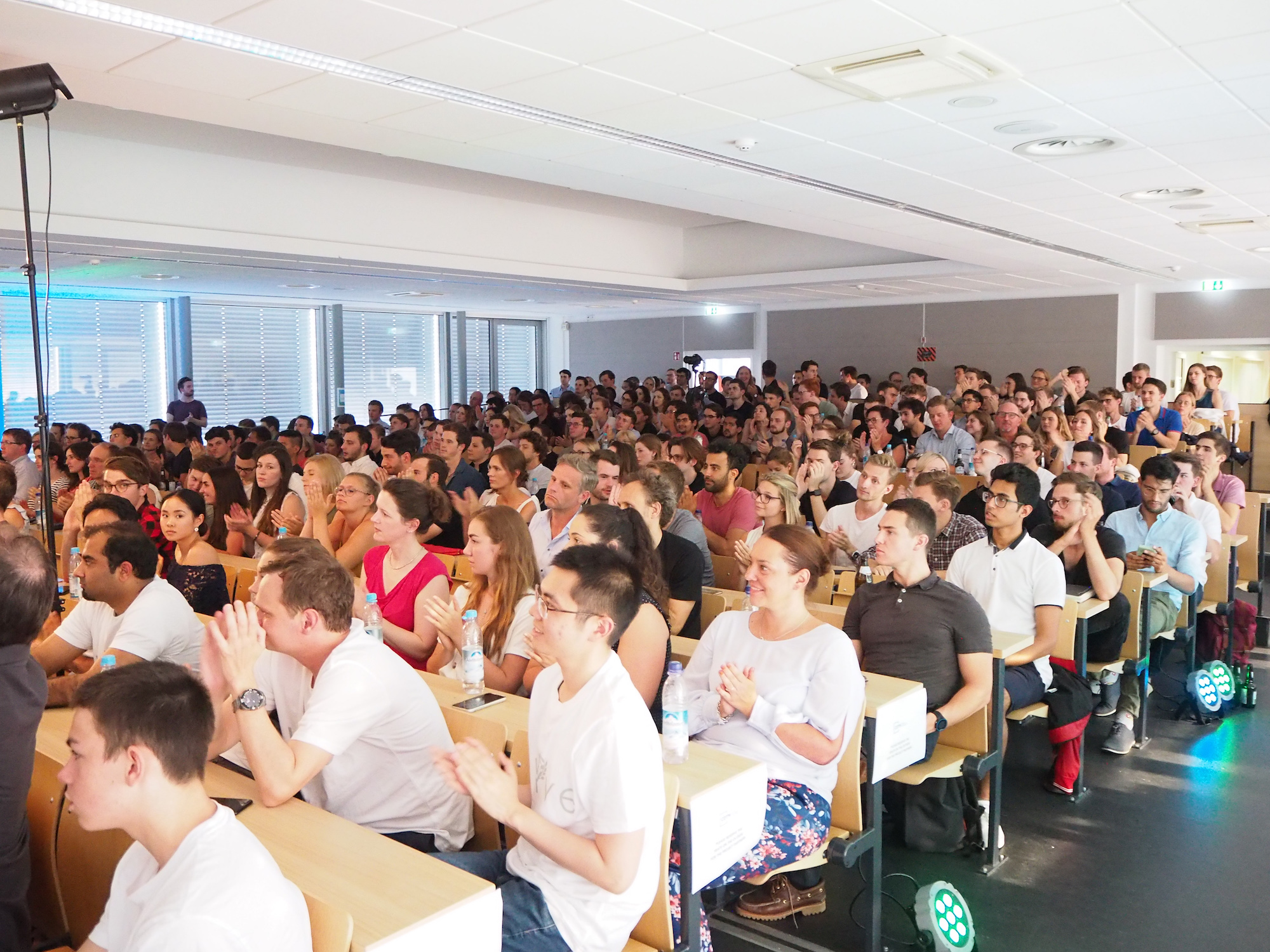 Excited Crowd Watching Students Pitch[/caption]
Concise answer: By utilizing a methodical approach. The MPD course facilitated our progress by numerous joint lectures attended by all teams.
A or perhaps the most important twist was to not jumpstart with an idea but rather define a problem and verify its existence first. Then, and only then, we should develop a solution. This development would take place under constant iterative feedback from actual users to avoid pouring resources into a product that in the end nobody wants to use.
Therefore, the first phase was the problem definition. Honestly, my group did not quite jumpstart this. We had some troubles to detect trends in our user research and to find consensus in what areas are useful to explore. However, we managed to overcome these obstacles and finally, agreed to follow through on the problem in the area of emergency transmission.
[caption id="attachment_15302" align="alignnone" width="941"]
Excited Crowd Watching Students Pitch[/caption]
Concise answer: By utilizing a methodical approach. The MPD course facilitated our progress by numerous joint lectures attended by all teams.
A or perhaps the most important twist was to not jumpstart with an idea but rather define a problem and verify its existence first. Then, and only then, we should develop a solution. This development would take place under constant iterative feedback from actual users to avoid pouring resources into a product that in the end nobody wants to use.
Therefore, the first phase was the problem definition. Honestly, my group did not quite jumpstart this. We had some troubles to detect trends in our user research and to find consensus in what areas are useful to explore. However, we managed to overcome these obstacles and finally, agreed to follow through on the problem in the area of emergency transmission.
[caption id="attachment_15302" align="alignnone" width="941"]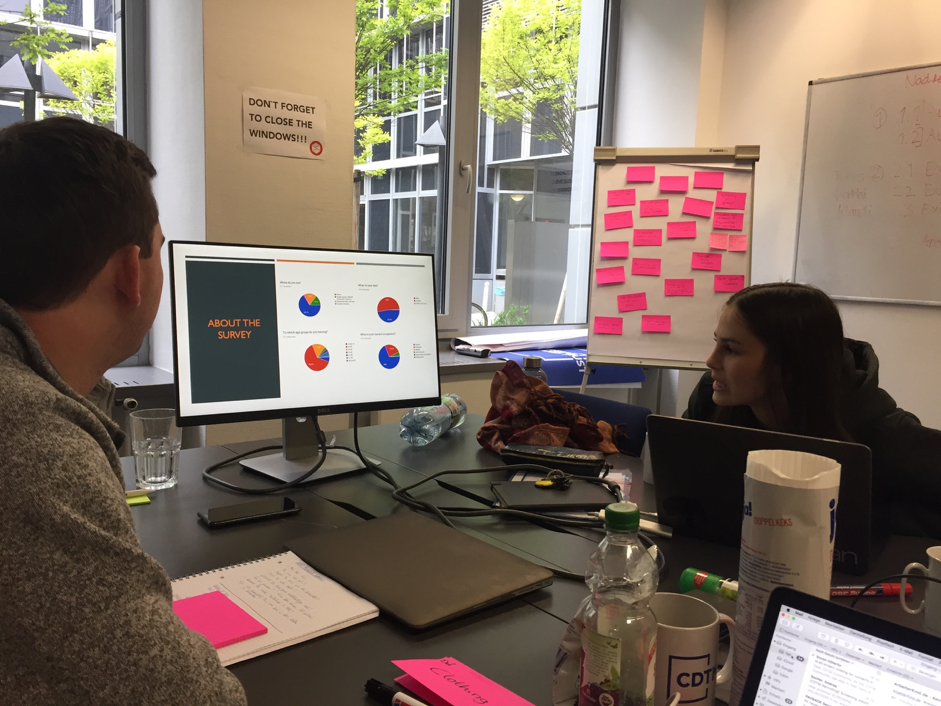 Discussing survey results to sharpen the understanding of the problem[/caption]
After the problem space was agreed upon, we let a first very rough prototype emerge from essence to form. This was facilitated during a paper prototyping session.
The key about these paper prototypes is that they are easy to make, easy to change, and not taken too seriously by any person you want to test your idea on.
Why is that an advantage you may ask? Easy, when a user does not assume you have put too much work into the prototype they will challenge the general concept, the whole idea, and the underlying assumptions. Even though their arguments might not convince you, they help to sharpen the idea.
If the prototype is too polished – to high fidelity – the feedback will target button colors or positioning. This might be what you want at a later stage but in this early stage, the question of interest is whether the solution can solve the problem, whether the whole user flow is organic, and not on whether to use marine blue or cyan.
[caption id="attachment_15301" align="alignnone" width="941"]
Discussing survey results to sharpen the understanding of the problem[/caption]
After the problem space was agreed upon, we let a first very rough prototype emerge from essence to form. This was facilitated during a paper prototyping session.
The key about these paper prototypes is that they are easy to make, easy to change, and not taken too seriously by any person you want to test your idea on.
Why is that an advantage you may ask? Easy, when a user does not assume you have put too much work into the prototype they will challenge the general concept, the whole idea, and the underlying assumptions. Even though their arguments might not convince you, they help to sharpen the idea.
If the prototype is too polished – to high fidelity – the feedback will target button colors or positioning. This might be what you want at a later stage but in this early stage, the question of interest is whether the solution can solve the problem, whether the whole user flow is organic, and not on whether to use marine blue or cyan.
[caption id="attachment_15301" align="alignnone" width="941"]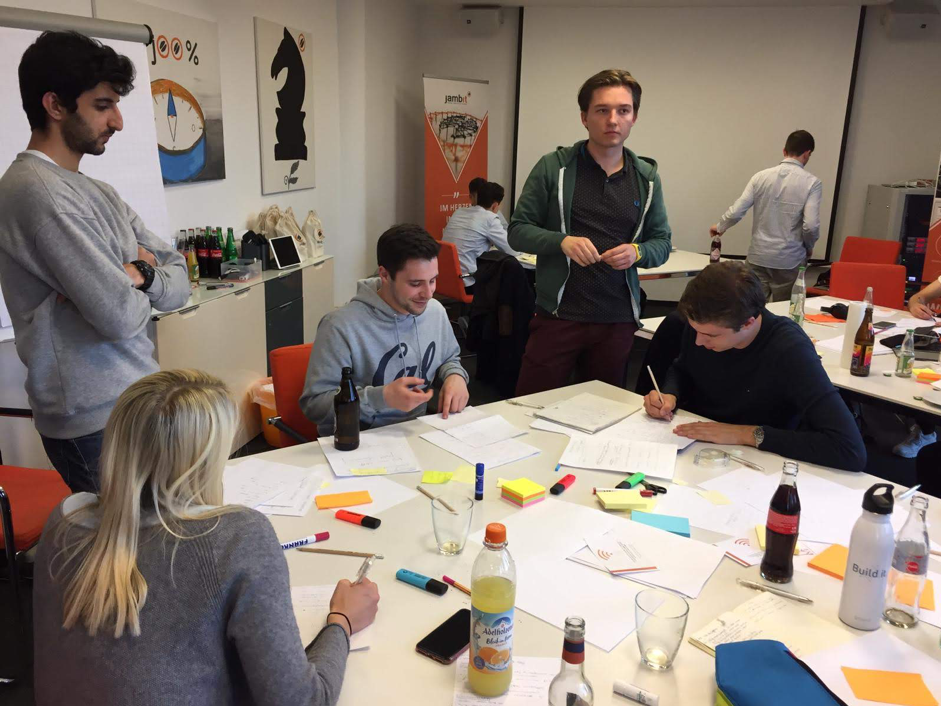 The first paper prototyping and testing session[/caption]
Additionally, we used our now well-tested paper prototype as a template for what we needed to program in our application. And the likelihood of needing to change the coded bits decreases, since we already verified positions of elements and the general flow of the application on paper.
For the whole development process, we used the SCRUM method as a project management tool. The results of every sprint, i.e. every iteration of the product, were feedbacked nonetheless. This feedback then also defines the targets for the next sprint.
However, developing a product is more facetted than just the problem and the solution. At least if one is interested in it being sustainable and used by people.
By sustainability, I am not talking about resource efficiency - though that is an important point. I am talking about whether an idea is logical in an economical sense. Only if people developing the idea earn more than they put into production, the product will continue to be produced.
Hence, all teams developed a business model. That includes straightforward issues such as a price and billing model, but also competition and market positioning have to be taken into account.
As a pat on the back, competition is usually a good sign. At least there is someone else out there, unrelated to you, who is willing to pour in resources money and manpower into a solution similar to yours. Beyond that, we made detailed business model plans and market sizing.
[caption id="attachment_15300" align="alignnone" width="941"]
The first paper prototyping and testing session[/caption]
Additionally, we used our now well-tested paper prototype as a template for what we needed to program in our application. And the likelihood of needing to change the coded bits decreases, since we already verified positions of elements and the general flow of the application on paper.
For the whole development process, we used the SCRUM method as a project management tool. The results of every sprint, i.e. every iteration of the product, were feedbacked nonetheless. This feedback then also defines the targets for the next sprint.
However, developing a product is more facetted than just the problem and the solution. At least if one is interested in it being sustainable and used by people.
By sustainability, I am not talking about resource efficiency - though that is an important point. I am talking about whether an idea is logical in an economical sense. Only if people developing the idea earn more than they put into production, the product will continue to be produced.
Hence, all teams developed a business model. That includes straightforward issues such as a price and billing model, but also competition and market positioning have to be taken into account.
As a pat on the back, competition is usually a good sign. At least there is someone else out there, unrelated to you, who is willing to pour in resources money and manpower into a solution similar to yours. Beyond that, we made detailed business model plans and market sizing.
[caption id="attachment_15300" align="alignnone" width="941"]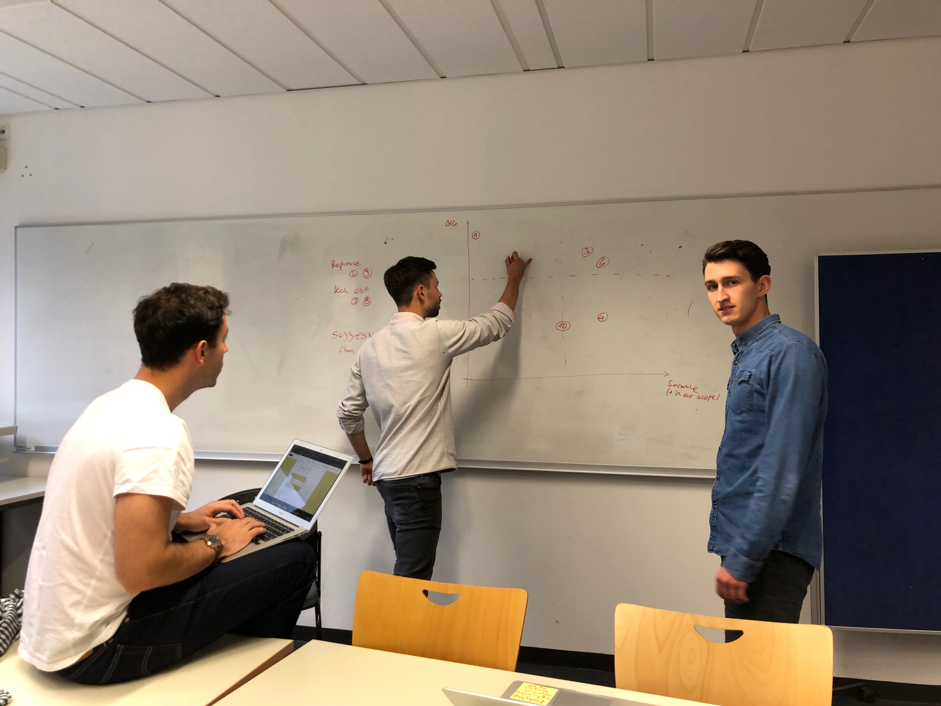 Intense discussion on market positioning[/caption]
Now, the last important thing is selling. We learned a lot about presenting during our ongoing milestone presentations of the course. For the final pitch at the Design Fair, however, we wanted to make everything right. Refining the final presentation, rewriting our text, switching slide order and deciding on necessary content is what filled up almost the whole last week. Medikura Co-Founder Philipp Nägelein also held a session on how to engage the audience leveraging ethos, pathos and logos.
And then: spotlight. On the 19th of July, we held our final pitches and presented our product in booths at the Design Fair – accompanied by custom-made marketing and concept posters.
SWAZO solved the problem of zombie meetings in big corporates. MEDCONNECT connects doctors. FLEXIFY extends your hotel stay. FAKTUAL enables journalists to save time researching. My team, KONEKTO, enables emergency calls anywhere and SVYVE. They simply aim to save the world by helping everyone to reduce their CO2 footprint.
These products are the result of three months of hard work, iteration, reiteration, and recurring reiteration of evermore refined ideas about the problem and its solution; developed in a constant dialogue with actual users. And this is how you learn new product development, fast!
[caption id="attachment_15322" align="alignnone" width="1800"]
Intense discussion on market positioning[/caption]
Now, the last important thing is selling. We learned a lot about presenting during our ongoing milestone presentations of the course. For the final pitch at the Design Fair, however, we wanted to make everything right. Refining the final presentation, rewriting our text, switching slide order and deciding on necessary content is what filled up almost the whole last week. Medikura Co-Founder Philipp Nägelein also held a session on how to engage the audience leveraging ethos, pathos and logos.
And then: spotlight. On the 19th of July, we held our final pitches and presented our product in booths at the Design Fair – accompanied by custom-made marketing and concept posters.
SWAZO solved the problem of zombie meetings in big corporates. MEDCONNECT connects doctors. FLEXIFY extends your hotel stay. FAKTUAL enables journalists to save time researching. My team, KONEKTO, enables emergency calls anywhere and SVYVE. They simply aim to save the world by helping everyone to reduce their CO2 footprint.
These products are the result of three months of hard work, iteration, reiteration, and recurring reiteration of evermore refined ideas about the problem and its solution; developed in a constant dialogue with actual users. And this is how you learn new product development, fast!
[caption id="attachment_15322" align="alignnone" width="1800"]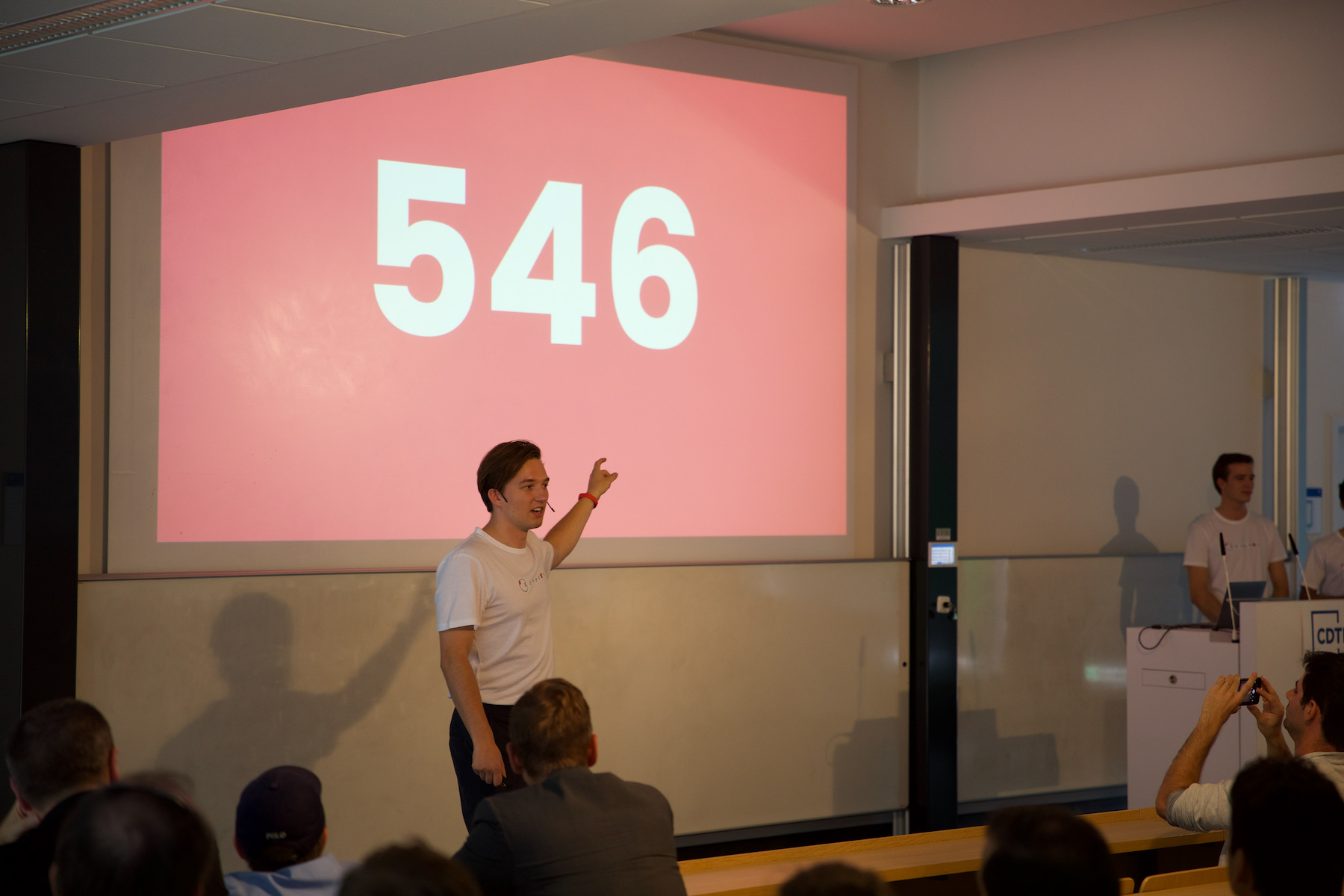 Konekto's Final Pitch At The Design Fair[/caption]
_______________________________________________________________________________________________
Lastly, how can you also learn new product development in 3 months? Do you also want to learn about entrepreneurship, and take part in the course Managing Product Development, or other courses at CDTM?
Become a CDTM student! Find out more about our Honours degree in Technology Management, and apply here until November 30th 2019!
Konekto's Final Pitch At The Design Fair[/caption]
_______________________________________________________________________________________________
Lastly, how can you also learn new product development in 3 months? Do you also want to learn about entrepreneurship, and take part in the course Managing Product Development, or other courses at CDTM?
Become a CDTM student! Find out more about our Honours degree in Technology Management, and apply here until November 30th 2019!